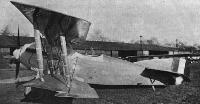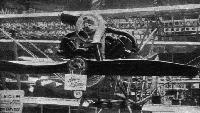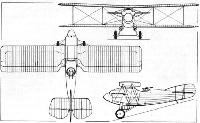
Flight, December 1922
THE PARIS AERO SHOW 1922
BOREL S.C.I.M. - PUTEAUX (SEINE)
The machine exhibited by Borel is an all-metal two-seater fighter and reconnaissance biplane with 300 h.p. Hispano engine fitted with one of the Rateau superchargers. The machine is built of metal throughout, Duralumin for spars, longerons, etc., and steel fittings. The fuselage is of tubular construction, Duralumin tubes being used for the longerons and struts, while the fittings are of sheet steel, wrapped around the longerons and secured by tubular rivets passing right through longeron and fitting. It is of interest to note that the diameter of the tubular longerons decreases from nose to stern. The method of reduction is to fit into the steel sockets an aluminium bush, into which the smaller tube fits. Thus at one end of the steel fitting the Duralumin tube just fits, while a t the other the bush makes up the difference in diameter between the two tubes. The bracing is piano wire with strainers in the rear portion, while in front the struts more or less triangulate the structure.
The wings are also built entirely of metal, Duralumin for spars and ribs, and steel for the bracing - wire fittings, etc. While the lower spars are in the form of rectangular-section Duralumin tubes, those of the top plane appear to be built up of Duralumin sheet to form a box section, reinforced internally by channel-section strips riveted to the flanges. The sides of both upper and lower spars have circular lightening holes, those of the upper spars being slightly flanged over, while those of the lower spars are quite plain.
The ribs have channel-section flanges, joined by channel-section stiffeners formed from Duralumin sheet. Leading and trailing edges are formed of sheet Duralumin in the shape of horizontal Vee sections. The top plane, which is of greater chord than the bottom, has an extra channel-section stringer behind the rear spar and trailing edges, as the spars are placed far forward in the wing section. The main spars are placed at a considerable angle to the chord line, presumably on account of the pronounced stagger. The wing fittings are of steel, and are in the form of stirrups going around the spars.
Wing roots permanently secured to the fuselage pass underneath the main fuselage structure, and a top centre-section is carried on struts. The attachment of end pieces to roots and centre-section is by horizontal unions parallel to, and on the centre line of, the spars.
As already mentioned, the Hispano engine is fitted with a Rateau supercharger, while on the rear end of the engine, immediately in front of the pilot, is an Odier engine starter. We believe the machine, fuselage as well as wings, is to be covered with fabric. It is shown in skeleton.
The main characteristics of the Borel Cap. 2, 1922, are as follows: Length o.a., 8 ms. 17 (26 ft. 10 ins.); span, 13 ms. (42 ft. 7 ins.); chord, upper 1 m. 90 (6 ft. 3 ins.), lower 1 m. 25 (4 ft. 2 ins.); wing area, 39 sq. ms. (420 sq. ft.); weight empty, 1,000 kgs. (2,200 lbs.); fuel. 325 kgs. (715 lbs.); useful load, 400 kgs. (880 lbs.); total loaded weight, 1,750 kgs. (3,850 lbs.). Fitted with supercharger the speed at ground level is estimated at 200 kms. (124 miles) per hour. The maximum speed is reached at 5,000 m., where it is 248 kms. (154 miles) per hour, and from then onwards the speed falls off, until at a ceiling of 10,000 m. (33,000 ft.) it is about 175 kms. (108 miles) per hour.
- Flight, December 1922
THE PARIS AERO SHOW 1922
Фотографии
-
Air International 1974-03 / Fighter A to Z (28)
The sole example of the Boccaccio-designed Borel two-seat fighter in its definitive form.
-
Flight 1922-12 / Flight
The Borel S.C.I.M. all-metal biplane.
-
Flight 1922-12 / Flight
The Rateau supercharger on Borel all-metal biplane.
-
Flight 1922-12 / Flight
SOME CONSTRUCTIONAL DETAILS ON THE BOREL BIPLANE: 1. Wing tip and details of all-Duralumin construction; the spars are Duralumin tubes of rectangular section, while the ribs built up of channel sections. 2. Stirrup attachments of wing-bracing wires, and interplane strut socket. 3. A typical fuselage fitting; the Duralumin tube longerons are stepped down in diameter, a bush being inserted in the parallel socket for the smaller tube.
- Фотографии





